This post will guide you through some remarkable small evergreen flowering shrubs, each promising unique characteristics and aesthetic contributions to your outdoor space.
Chinese Fringe Flower
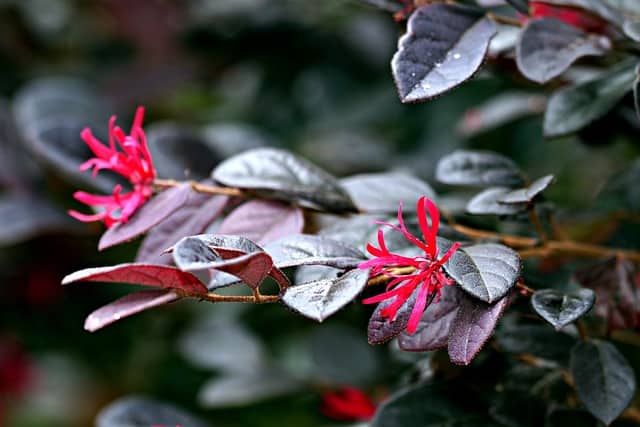
The Chinese fringe flower (Loropetalum chinense) is a standout evergreen shrub esteemed for its vibrant, fringe-like blooms. Native to China, Japan, and the Himalayas, this plant thrives in a variety of climates. The most common varieties exhibit pink or white flowers that bloom profusely in early spring, releasing a delightful fragrance that attracts pollinators.
What sets the Chinese fringe flower apart is its appealing foliage, which can range from deep green to a captivating burgundy hue. This makes it a dynamic choice for borders or as a low hedge. It grows best in full sun to partial shade and is tolerant of a diverse range of soil types, making it adaptable to various garden conditions. Its versatility and low maintenance needs make it an excellent choice for both novice and experienced gardeners looking to add a splash of color to their landscapes.
Gardenia
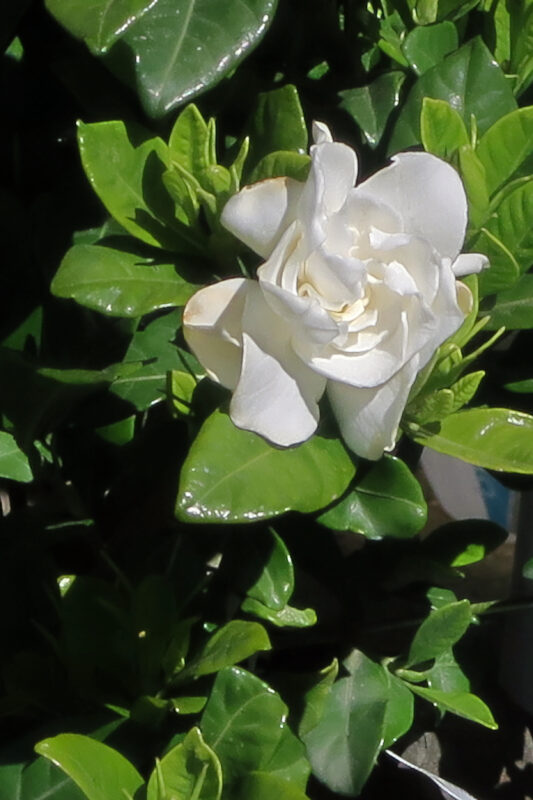
Gardenias (Gardenia jasminoides) are cherished for their creamy white flowers and intoxicating fragrance, which has made them a popular choice in gardens and landscapes. The glossy green leaves form an attractive backdrop for the star-shaped flowers, which bloom throughout the summer.
Gardenias thrive in well-drained, acidic soils. They prefer a sunny location with some protection from harsh afternoon sun, especially in hotter climates. Their aromatic blooms are a favorite for cut flowers, bringing a wonderful scent indoors. Besides their beauty and fragrance, gardenias have cultural significance and are often associated with love and purity.
These plants are relatively forgiving, but they do require consistent moisture. With a little care and the right conditions, a flourishing gardenia can be the crowning jewel of your garden, bringing both visual beauty and olfactory delight.
Japanese Pieris

Japanese pieris (Pieris japonica), also known as andromeda or lily-of-the-valley shrub, is a unique evergreen shrub renowned for its elegant, cascading clusters of bell-shaped flowers that appear in early spring. The blooms are typically white or pink, adding a delicate touch to gardens.
This shrub is perfect for shaded or partially shaded areas, as excessive sunlight can scorch its leaves. It prefers acidic soil and is valued for its attractive foliage—new growth emerges in striking shades of red before maturing to glossy dark green. Japanese pieris is a popular choice for woodland gardens, providing year-round interest with its seasonal blooms and changing leaf colors.
In addition to its aesthetic appeal, Japanese pieris is resilient, resisting many common pests and diseases. Its ease of care and adaptability to a variety of garden styles contribute to its enduring popularity among gardeners.
Camellia
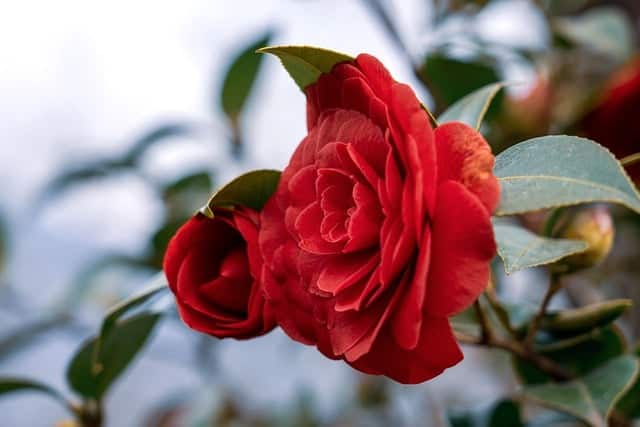
Camellia species are a timeless classic in the realm of evergreen flowering shrubs. The most commonly cultivated varieties, such as Camellia japonica and Camellia sasanqua, captivate with their stunning flowers that come in a range of colors— from white to deep red, often with beautiful variegation.
Blooming typically in late winter to early spring, these blossoms can brighten even the dreariest of days. Camellias thrive in well-drained, acidic soil and prefer a partially shaded location, protecting their delicate blooms from the harsh glare of the sun.
Apart from their alluring flowers, camellias also boast attractive, leathery foliage, providing a lush backdrop throughout the year. Their shape lends itself well to formal hedges or naturally shaped masses in garden beds. With proper care, including regular pruning and fertilization, these shrubs can live for decades, making them a gratifying investment in your garden.
Mountain Laurel
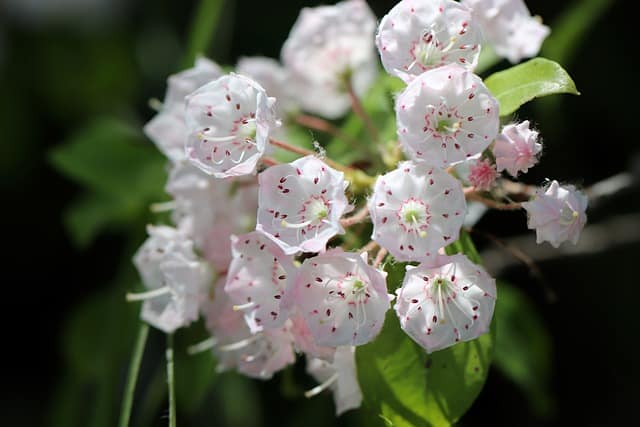
Mountain laurel (Kalmia latifolia) is a truly remarkable shrub that showcases clusters of exquisite, intricate flowers in late spring. Native to the eastern United States, this evergreen shrub has a unique adaptability to various soil types, although it favorably grows in acidic environments.
The flowers present in a range of colors, from white to pink to crimson, often with striking dark markings. The glossy dark green leaves also add to the plant’s year-round appeal. Mountain laurel prefers partial to full shade, making it an excellent choice for woodland gardens or shaded areas where other flowers may struggle.
Its resilience to pests and diseases is an added bonus for gardeners. When thoughtfully placed alongside ferns and other understory plants, mountain laurel can create beautifully layered landscapes that echo the natural beauty of the woodland setting.
Japanese Skimmia
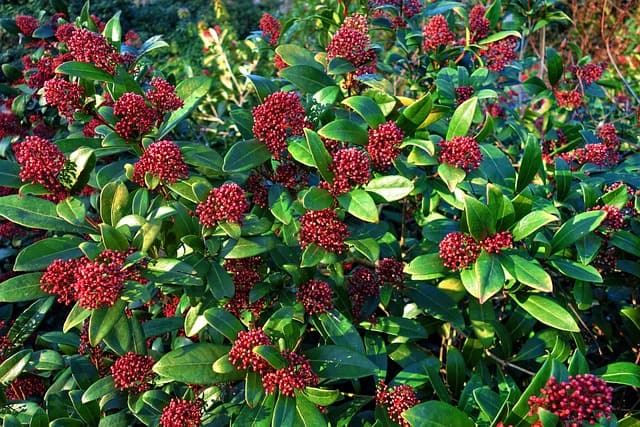
Japanese skimmia (Skimmia japonica) is a lesser-known shrub cherished for its fragrant flowers and attractive foliage. The plant features glossy dark green leaves, which serve as a perfect backdrop for the small clusters of white flowers that bloom in spring.
What makes Japanese skimmia particularly interesting is its ability to thrive in shaded areas, making it invaluable for gardens where sunlight is limited. Additionally, it is dioecious, meaning that male and female plants are required for fruit production; female plants will develop bright red berries if a male counterpart is present. This adds a unique layer of interest to the landscape, especially in late summer and autumn.
Japanese skimmia prefers well-drained, acidic soil and is relatively low maintenance, making it suitable for novice gardeners looking to enhance their outdoor space with minimal fuss. It’s an invaluable addition for woodland gardens and can also work beautifully in mixed borders.
Azalea
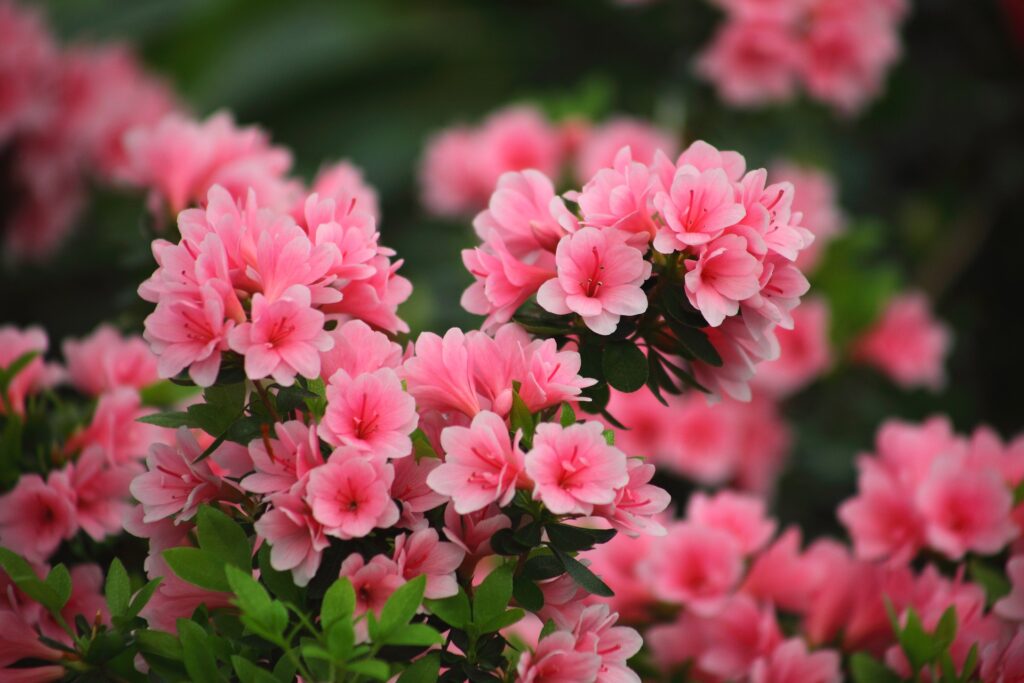
Azaleas, particularly the evergreen varieties, are well-loved among garden enthusiasts for their stunning, colorful blooms that can brighten up any garden. These shrubs are available in an array of colors, including pink, purple, red, and white. They bloom in spring, creating a vibrant display that draws attention.
Azaleas prefer acidic, well-draining soils and thrive in partial shade, although certain varieties can tolerate more sunlight. Their delicate blossoms combine beautifully with their polished green leaves, creating a lush appearance that remains attractive beyond the flowering period.
These shrubs also have a fascinating diversity in form, from compact dwarf varieties to larger shrubs, making them versatile for different garden settings. Care typically involves regular watering and prudent pruning after blooming to maintain shape and encourage healthy growth. With their remarkable blooms and adaptability, azaleas are a garden staple that offers multiple seasons of interest.
Cherry Laurel
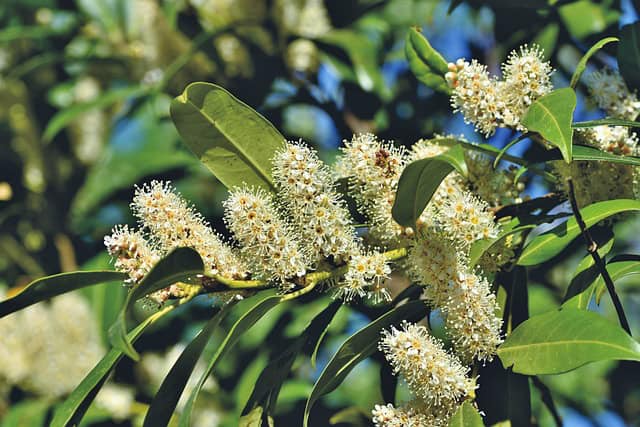
Cherry laurel (Prunus laurocerasus) is a robust evergreen shrub that serves many purposes in landscape design. Recognized for its glossy dark green leaves, cherry laurel is often used as a privacy hedge or border plant due to its dense growth habit. In late spring, it produces fragrant white flowers, which while not as showy as other shrubs, appeal to pollinators.
This plant is highly adaptable, thriving in both sun and shade, and it’s tolerant of a variety of soil types. The leaves can be quite large, contributing to a lush feel in landscaping. However, it’s important to note that cherry laurel can become invasive in some areas due to vigorous growth, so it is best planted with consideration of its potential spreading.
Cherry laurel is relatively low maintenance but benefits from periodic pruning to maintain its desired shape. This shrubby evergreen is an excellent option for those seeking a practical yet visually appealing addition to their gardens.
Rhododendron
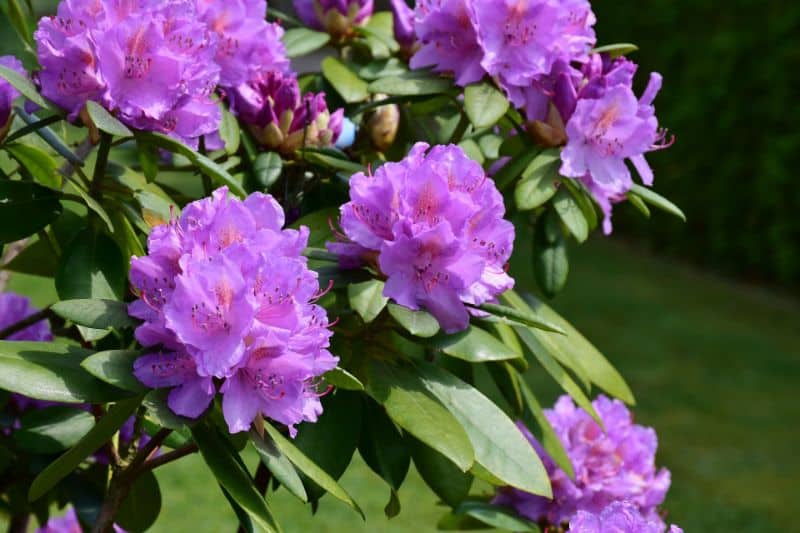
Rhododendrons are a beloved group of evergreen flowering shrubs that captivate with their large, dramatic blooms in spring. The flowers come in a multitude of colors, including purple, pink, white, and even variegated varieties, making them a dazzling focal point in any garden.
These shrubs thrive in acidic, well-draining soil and prefer locations with partial shade, making them ideal for woodland gardens or areas where other plants may be more vulnerable to harsh sunlight. The leathery leaves provide attractive greenery year-round, while the flowering season brings forth a spectacular display.
Rhododendrons do require specific care, including protection from extreme drought and heat. Regular pruning after flowering will promote healthy growth and maintain shape. With proper maintenance, rhododendrons can live for many years, enhancing your garden with their majestic beauty and providing habitat for local wildlife.
Rockspray Cotoneaster

Rockspray cotoneaster (Cotoneaster horizontalis) is a compact and low-growing evergreen shrub that offers unique architectural beauty and versatility in landscaping. Its horizontal growth habit makes it an excellent choice for ground cover, rock gardens, or cascading over walls.
In late spring, this shrub produces small, white flowers, which give way to bright red berries in the fall, attracting birds and other wildlife. The oval, dark green leaves turn a lovely shade of bronze in autumn before shedding, providing visual interest throughout the changing seasons.
Rockspray cotoneaster is drought-tolerant once established and thrives in a range of soil types. Its low maintenance nature makes it suitable for both novice gardeners and seasoned horticulturists. Additionally, its ability to adapt to various garden settings allows it to flourish in city gardens, coastal regions, and rural landscapes.
Daphne
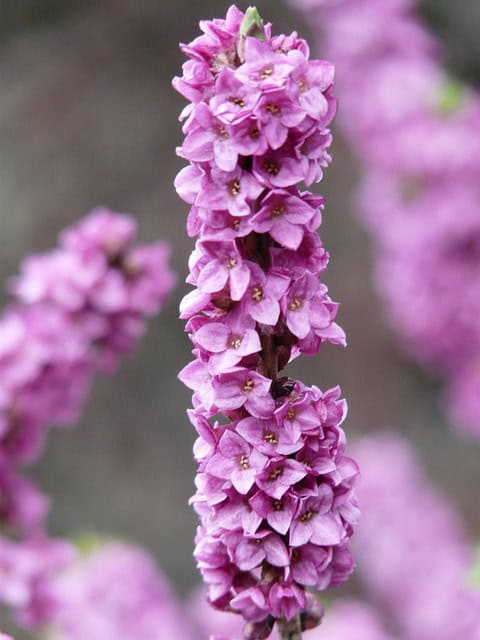
Daphne species are highly prized for their sweetly fragrant flowers that bloom in early spring. These compact shrubs, such as Daphne odora, stand out with their rosy and white blooms, which emit a delightful scent that many find irresistible.
Most daphne varieties prefer partial shade and well-drained soil, making them perfect candidates for borders or shady areas where other flowering plants may not perform as well. They often have leathery, evergreen leaves that maintain a rich green color throughout the year, adding to their visual appeal even when not in bloom.
Daphne tends to have a reputation for being somewhat finicky. They require proper planting conditions and patience, as they can take a while to establish. However, once settled, they reward gardeners with years of fragrance and beauty, making them worth the effort and care.
Holly
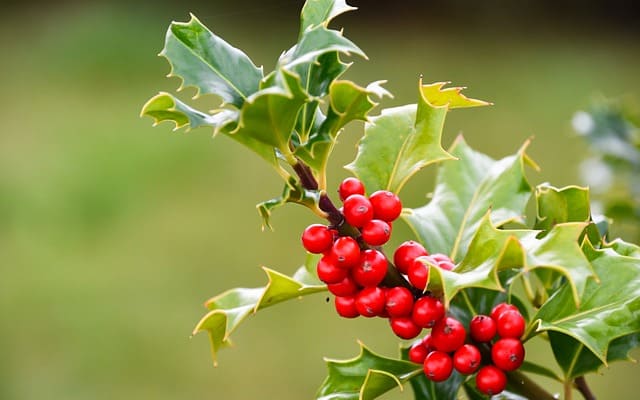
Holly (Ilex) is an iconic evergreen shrub known for its attractive spiny leaves and bright red berries. Commonly associated with winter festivities, holly’s year-round appeal makes it a beloved addition to gardens. Several species, including Ilex crenata and Ilex aquifolium, are frequently used in landscaping.
Holly requires well-drained, acidic soil and prefers partial to full sun. The berries are produced only on female plants when a male counterpart is present; thus, it’s essential to plant both for berry production. Holly shrubs not only enhance the garden visually, but also provide a vital food source for birds and other wildlife during the harsh winter months.
Due to its dense foliage and resilient nature, holly is often used for hedges, privacy screens, or as standalone specimens. With seasonal pruning, holly can be shaped into a desired form, making it a versatile choice for both traditional and contemporary gardens.
Mahonia

Mahonia, commonly known as Oregon grape, is a lesser-known but invaluable evergreen flowering shrub. Characterized by its holly-like leaves, Mahonia aquifolium blooms with clusters of vibrant yellow flowers in early spring, followed by blue-purple berries.
This shrub is particularly valued for its adaptability to shady environments, thriving under tree canopies or in woodland gardens. Mahonia is highly resilient, capable of withstanding varying soil conditions and is relatively low-maintenance once established.
Its foliage exhibits a stunning transformation during fall, turning to a rich purple-red color, extending its seasonal interest. With its attractive flowers and berries, Mahonia serves as both an aesthetic and ecological addition, providing forage for pollinators and birds.
Flowering Rosemary
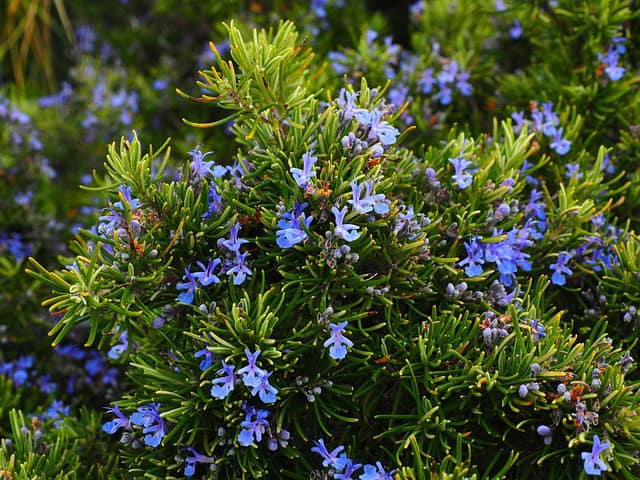
While typically known as a culinary herb, rosemary (Rosmarinus officinalis) can also be beautifully incorporated into gardens as an evergreen flowering shrub. Its aromatic leaves pair well with its delicate blue flowers that bloom intermittently throughout the year, offering fragrance and flavor.
Rosemary thrives in well-drained soil and requires full sun for optimal growth, making it ideal for sunny borders or herb gardens. Beyond its culinary uses, rosemary is cherished for its drought-tolerance once established, reducing the need for frequent watering.
When pruned regularly, rosemary can be shaped into an attractive hedge or left to grow more naturally. As one of the most enduring and useful plants in any garden, rosemary offers both aesthetics and practicality, serving as a herb while enhancing the beauty of your space.
Abelia
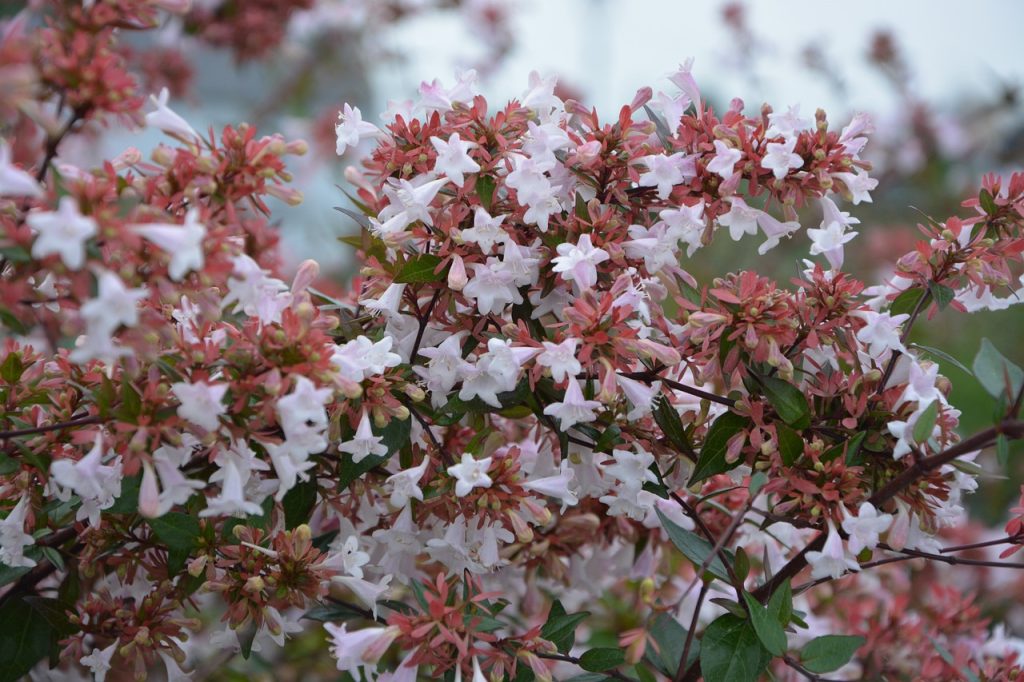
Abelia (Abelia x grandiflora) is a charming evergreen shrub characterized by its glossy foliage and tubular flowers, which bloom in soft shades of white, pink, and lavender throughout summer. This shrub is appreciated for its ability to provide continual flowering, attracting butterflies and pollinators into the garden.
Abelia adapts well to different soil types and light conditions, thriving in full sun to partial shade. It typically has low water requirements once established, making it easy to maintain in various climates.
The semi-woody nature of abelia allows it to be pruned for desired shape or size, making it suitable for borders, hedges, or even as standalone feature plants. Its lovely blooms and resilient nature award abelia a deserving spot in any landscape.
Japanese Pittosporum

Japanese pittosporum (Pittosporum tobira) is an evergreen shrub that captivates with its glossy leaves and delightful fragrance. Often used as a hedge or screening plant, it provides a lush and tropical feel to gardens. The small, creamy flowers appear in spring and are known for their enticing scent.
This shrub flourishes in well-draining soil and requires full sun to partial shade, showcasing its resilience in different environmental conditions. Japanese pittosporum is also relatively drought-tolerant, making it suitable for less water-intensive gardens.
The versatility of this shrub extends to its aesthetic possibilities; it can be pruned into formal shapes or left to grow more naturally depending on your garden’s design. With its lush appearance and fragrant blossoms, Japanese pittosporum offers both practical appeal and beauty in your landscape.
Burkwood Viburnum

Burkwood viburnum (Viburnum x burkwoodii) is a hybrid evergreen shrub that enchants gardens with its lovely white to pink flowers that blossom in clusters during spring. Alongside its fragrant blooms, the glossy leaves provide an attractive presence all year round.
This shrub loves well-drained soil and prefers full sun to partial shade, making it adaptable to different garden settings. The Burkwood viburnum is particularly noted for its resilience, overcoming many common pests and diseases that affect flowering shrubs.
With a rounded growth habit and ability to tolerate pruning, it makes an excellent choice for formal or informal hedges. Its combination of fragrance and visual appeal enriches garden spaces, attracting pollinators and contributing beauty throughout the seasons.





